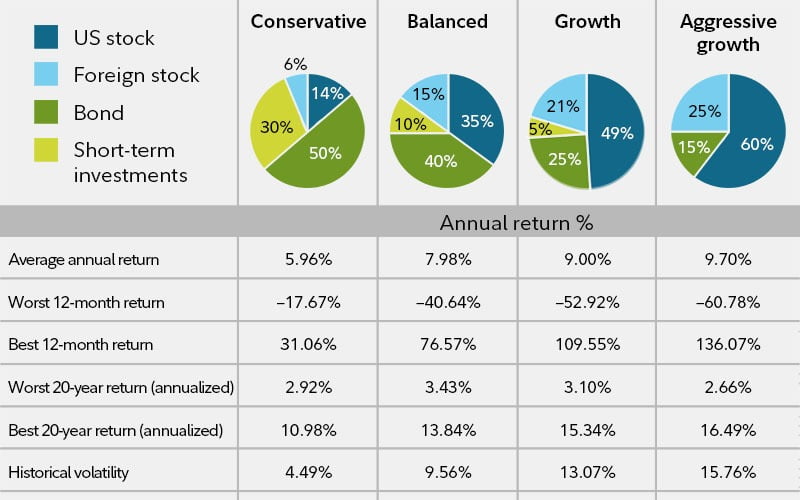This post may contain affiliate links. We may receive compensation when you click on links to those products at no additional cost to you. Read our full disclosure here.
One of the keys to successful investing is knowing what type of investor you are. This is because there is no one-size-fits-all type of portfolio as everyone has varying risk tolerance, time horizon, investing styles, knowledge, as well as the comfort level in investing. Thus, understanding who you are as an investor will ultimately drive your investment strategies and overall expectations to ensure that your financial goals and objectives are met.
Risk Tolerance
The first thing that every investor has to figure out is their risk tolerance. Risk tolerance is essentially how comfortable you are at the risk of losing money. If you have a high-risk tolerance, you can make riskier investments, if you have a low-risk tolerance, you will want to make safer investments.
Generally speaking, investors with longer investing time horizons will have higher risk tolerance as they have more time to recover from downturns as compared to someone who has a short time horizon.
Here are some important factors when considering one’s risk tolerance:
- Time horizon: As mentioned, if you have a longer time horizon to ride out the market downturns, you can afford to take on more risk. Historically, the US stock market tends to go up in the long run but can fluctuate in the short term. To illustrate this, a 25-year-old investor who is focused on growing their investments will probably have a higher risk tolerance than a 65-year-old retiree who is focused on preserving what they have. If the market tanks and the retiree has all his money in the stock market, they may be forced to sell their stocks at the bottom for retirement income as compared to a 25-year-old who can hold it out and wait for the market to recover.
- Age: If you are younger and don’t need the money anytime soon, you probably can take more risks as you have a longer time horizon.
- Goals: Those with a goal of growing their money aggressively will have a higher risk tolerance than someone who has a goal of preserving their money.
- Portfolio size: The larger the portfolio, the more risk you may be able to take. A $50M portfolio with a loss of $5,000 will hurt less than a $10,000 portfolio with a loss of $5,000.
- Personality: Some people are just naturally risk-takers. They don’t mind the adrenaline and don’t shy from risks which means that they are comfortable with risks.
A good question to ask yourself when determining your risk tolerance is “If the stock market drops 40% tomorrow, how would you feel?”. If you can stomach that drop, you may have a higher risk tolerance; and if that makes you queasy, you may have lower risk tolerance. Do note that ALL investments have risk, it is a matter of minimizing it while maximizing reward.
So why would someone take on more risk? Risk and reward typically go hand in hand, as someone who is risking more money will generally expect to have a greater reward/return for it. #norisknoreward Thus, understanding your risk tolerance is an important factor to know what type of investor you are as that will affect how you invest in your portfolio. Below is a risk-return illustration from Fidelity to demonstrate how risk can affect your returns:

Investing Style
Next, you’ll need to know what type of investor you are by figuring out your investing style(s). When it comes to investing styles, there are many ways that one can choose to invest. Each investing style has its pros and cons, and they are not exclusive in the sense where you must pick one and not the others. However, knowing whICH investor style suits you best is important as it’ll determine how you WILL invest consistently moving forward.
Here are 6 of the most common investing styles:
Passive Investing
Passive investors’ goal is not to beat the market, but to match it by investing in certain market indexes – like the S&P 500. By buying and holding market indexes through ETFs and mutual funds and other investments, an investor can:
- Minimize transactions and taxes incurred.
- Be diversified as indexes tracks many different stocks.
- Avoid missing out on the investments’ gains during positive days.
- Approach investing in a less emotional way.
Active Investing
Active investing takes on a more hands-on approach to investing. This investing style will involve extensive research and due diligence on stocks and trying to formulate a portfolio to beat the market or a selected benchmark. As the market condition changes frequently, an active investor may have to make more trades to achieve its goals of beating the market. Some characteristics of active investing are:
- Higher costs as you probably have to pay someone to do actively manage investments.
- More trades = potential taxes on and gains.
- Trying to beat the market is risky but can be rewarding if successful.
- According to S&P Dow Jones Indices’ SPIVA (S&P Indices Versus Active) Scorecard, about 81% of actively managed funds underperformed their benchmarks.
- This means that you could’ve just bought and hold an index fund and still beat those that are trying to time and beat the market actively 81% of the time!
Growth Investing
Growth investing focuses on picking companies that have a high growth potential in the future. In today’s world, most tech stocks are considered growth companies as they have high growth potential due to innovation and revenue growth. These companies will also be focused on reinvesting their profits into the business to continue fueling growth higher. Here are some identifying traits of a growth company:
- High earnings per share (EPS)
- High revenue and profit growth
- High return on equity (ROE)
- Could be because of debt to fund business endeavors
- High profit margins
- Reinvests profits into the business, which also means you’ll probably not receive dividends
Value Investing
Value investing focuses on picking undervalued companies compared to its competitors and peers. This strategy hopes to capitalize on companies that are cheap for whatever reason and ride the stock back up higher to its perceived value. Here are some identifying traits of a value company:
- Low price-to-earnings (P/E) ratio
- Low price-to-book (P/B) ratio
- Low price-to-sales (P/S) ratio
- Mature companies that pay a dividend consistently
- Rich in cash and assets
- Low debt
Income Investing
Income investing is an investment style that focuses on investing in income-generating assets. This is one of the best ways to generate constant passive income to support your lifestyle, goals, and objectives. Besides, most income-generating assets can also appreciate in value so that you can benefit from that when you sell them too. The three main ways for income investing is through:
- Dividends from stocks
- Dividends from Real Estate Investment Trust (REIT)
- Bonds
- Owning rental properties
Speculative Investing
Speculative investing is probably closer to gambling than investing. This is because you’ll be focusing on trying to find the “next big thing” and hit a home run on it. These investments are typically riskier and can either go to the moon or crash and burn. Some characteristics of speculative investments are:
- Newer companies with not much history
- Big potential but short on cash
- This means they have to take on more debt or raise capital to grow which is will hurt shareholders’ value.
- May not have solid proof of concept for its product or services
- Frequent pumps and dumps on the stock
- Big potential but management is failing to execute and deliver on promises
As of 2021, speculative investing has been rampant especially with the rise of GameStop, DOGE Coin, AMC, WallStreetBets, meme stocks, etc. Be cautious when determining what type of investor you are as speculation typically doesn’t end well for most!
Summary
Once you’ve determined your risk tolerance, you can then figure out which investment style suits you and your risk tolerance best. Remember that each investing style has its own pros and cons, and you can most definitely apply a combination of two or more investing styles depending on what type of investor you are.
The opinions expressed in this article are for general information purposes only and are not intended to provide specific advice or recommendations about any investment product or security. If you have questions pertaining to your individual situation you should consult your financial advisor.
This post may contain affiliate links. We may receive compensation when you click on links to those products at no additional cost to you. Read our full disclosure here.






